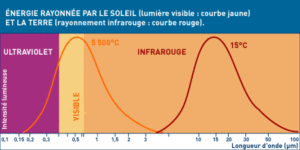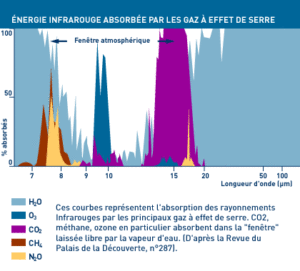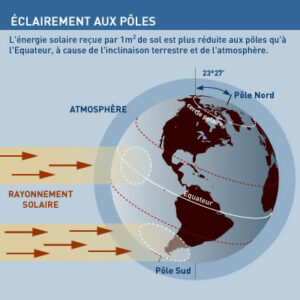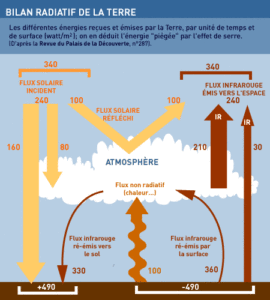
CONTENTS
OCEAN AND MARINE LIFE
- THE ARCTIC OCEAN AND THE OCEAN CURRENTS
- GENESIS OF THE ARCTIC OCEAN
- ARCTIC PLANKTON
- MARINE BIODIVERSITY AND FOOD WEB
- WHALES AND OTHER CETACEANS
- SEALS AND WALRUSES
TERRESTRIAL LIFE
- POLAR FLORA
- POLAR FAUNA
- THE POLAR BEAR
- ARCTIC BIRDS
- SPECIES EVOLUTION AND CLIMATE
HISTORY AND GEOGRAPHY
- GEOGRAPHY OF THE ARCTIC REGIONS
- GEOGRAPHIC NORTH POLE, MAGNETIC NORTH POLE
- WHO OWNS THE ARCTIC?
- THE EXPLORERS OF THE FAR NORTH
- THE INUIT
- OTHER PEOPLES OF THE FAR NORTH
- THE ARCTIC TODAY
THE SUN, HEATING THE EARTH
A tremendous source of energy warms our planet: the Sun. Part of the rays that reach Earth are reflected or absorbed by the atmosphere. The rest reaches the ground, which reflects and absorbs some of it again. The warmed atmosphere and ground (or ocean) in turn emit so-called infrared radiation into space. The difference between the energy gained by Earth and the heat radiated back is called the radiative balance (regional or for the entire planet).
WARM TROPICS, COLD POLES
Earth is not uniformly heated by the Sun: the Equator receives more energy than the poles. Indeed, Earth is round and tilted on its axis. At the poles, solar rays are therefore grazing; they pass through a thicker layer of atmosphere, absorbing a lot of energy, and the ‘heat’ received is distributed over a larger surface.
TWO COLD SINKS
In winter, the polar night is very long. Without sunlight, it is cold; furthermore, Earth continues to radiate its own energy into space, thus losing even more heat. In summer, snow and ice reflect a large part of the Sun’s rays like a mirror without absorbing them (albedo). Overall, polar regions lose more energy than they receive.
AROUND THE GLOBE: HEAT EXCHANGES
The poles should become increasingly colder and tropical zones warmer; but this excess tropical heat is absorbed by the ocean and atmosphere, which transport it towards the cold regions. Thus, a global equilibrium is established. However, on a planetary scale, if the radiative balance becomes positive, Earth warms; if it is negative, it cools.


VISIBLE OR INFRARED? EACH WITH ITS OWN RADIATION
The Sun primarily emits electromagnetic waves of short wavelengths (<4µm), including visible light. Part of this energy is re-emitted by the Earth as long-wavelength electromagnetic waves (>4µm): that is, in what is called thermal infrared; because the Earth, like any “hot” body, behaves like a radiator: it radiates into space.
Currently, the solar flux measured at the top of the atmosphere, a few tens of kilometers in altitude, averages 340 watts per m2 (in fact, 1,368 W/m2 on a surface that would be everywhere perpendicular to the light flux: but the Earth is a sphere…). The ground and atmosphere reflect an average of 30% of the solar flux. The rest, approximately 240 watts per m2 absorbed and converted into heat, is used to maintain temperature, set the atmosphere and ocean in motion, evaporate water, etc., thus fueling the planet’s “thermal engine” and regulating climates.
A flux roughly equivalent to the 240 watts per m2 supplied by the Sun is re-emitted into space.
POLAR WINTER AND SUMMER
At high latitudes, in winter, there is no solar radiation: the night lasts 6 months at the pole, 4 months at 80° latitude, and 2 months at 70°. It is therefore very cold, because not only is there very little heat input, but also, the emission of ‘thermal’ infrared radiation persists (although snow and sea ice form an insulating blanket, which limits this loss).
In summer, on the contrary, 24-hour sunlight is very favorable for warming: for about 2 months, around the solstice, the number of calories per m² received per day is greater at the poles than at 40° latitude! The effect is reinforced by other factors (orientation, etc.), so that, sometimes, temperatures are relatively high for a small part of the year. However, the sun remains low (less than 150 watts/m² at ground level), and snow and ice reflect up to 80% of solar radiation (albedo): the energy reflected by Earth into space is therefore always very significant at the poles, even in summer. Consequently, ice caps remain in place and the melting of sea ice is delayed.

ENERGY REFLECTED BY EARTH (ALBEDO)
| Cold fresh snow | up to 90-98% |
| Melting snow | 50-60% |
| Melted, dirty snow | 40% |
| Glacier | 50% |
| Ocean | 5-15% |
| Sea ice | 50-85% |
| Sand desert | up to 35% |
| Bare rocks | 20-25% |

GREENHOUSE EFFECT AND RADIATIVE BALANCE
If the atmosphere were completely transparent to the infrared radiation emitted by Earth, it would be much colder (on average -18 °C); but the atmosphere (gases, water vapor) absorbs part of this radiation and in turn radiates infrared energy back to Earth, which thus maintains an average temperature of +15 °C: this is the greenhouse effect.
The surface temperature due to this phenomenon corresponds to an upward IR thermal flux of approximately 390 W/m²; 240 will be lost to space, with the atmosphere retaining 150 (greenhouse effect); in addition, 100 W/m² of non-radiative energy ‘rising’ from the ground (convection…) and 80, directly absorbed from the 240 of incident solar energy, are added to the atmosphere. Ultimately, 330 W/m² are thus ‘trapped’ in the atmosphere and radiate towards the ground (downward IR thermal flux).
Any increase in the greenhouse effect tends to increase this balance by decreasing the emitted energy.
SATELLITES MONITORING EARTH
Climate is the consequence of the planetary radiative balance. Knowing this balance with maximum precision is essential for monitoring climate evolution. Satellites measure the radiative balance at the top of the atmosphere, in watts per square meter. When the global balance is zero, Earth remains in thermal equilibrium. If this balance becomes positive, Earth warms; if it is negative, it cools.
All the latest measurements seem to indicate a positive balance.
THE PHYSICISTS’ CORNER
Any body emits thermal energy W (in joules) equivalent to that of a ‘black body’, solely as a function of its absolute temperature T (in Kelvin) according to the law W=sT4, where s is a constant coefficient (Stefan’s law). This applies to the Sun, but also to Earth, the ocean, ice, etc.
DID YOU KNOW?
Our planet intercepts only a very small part (one billionth) of the energy emitted by the Sun. This still corresponds to 10,000 times more power (175 million megawatts) than that consumed by humanity! The geothermal flux from our globe’s internal heat, however, is 4,000 times lower (0.09 W/m²).
Sea ice is capable of almost completely stopping exchanges between the ocean and the atmosphere. This is referred to as a thermal lid. The impermeability of this lid depends on its distribution and thickness. However, it exhibits a certain transparency to solar radiation, which allows for the partial penetration of visible light into the ocean and the development of marine organisms under the ice.


